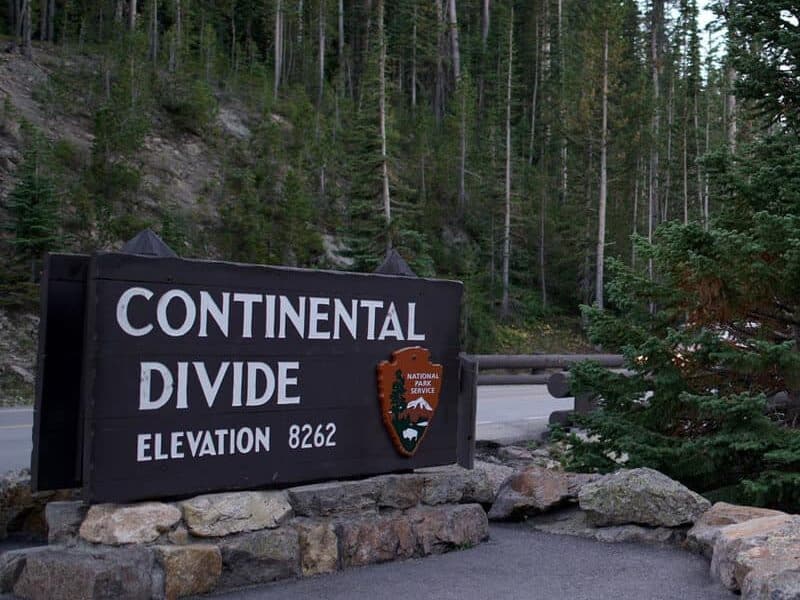The Continental Divide—the backbone of North America's Rocky Mountains and the boundary separating waters that drain to the Pacific and Atlantic oceans—cuts through the northern section of Yellowstone National Park.
In this iconic landscape, one can witness firsthand how surface waters are forever set on diverging paths based on the terrain.
Minor elevation changes dictate whether rain or melting snow will flow northwest towards the Columbia River, northeast to the Missouri drainage, or southwest into the Colorado River system.
This article provides insight into Yellowstone's role in the Continental Divide, how it shapes the area's diverse ecology, and how visitors can explore its natural wonders.
Understanding the Continental Divide
The Continental Divide, an invisible boundary stretching nearly 3,100 miles across North America, traces the Rocky Mountains' crest and dictates whether waters flow to the Pacific or Atlantic Ocean.

When you're at Yellowstone's section of the divide, you witness waters setting off on distinct paths.
This impressive mountain range governs the routes of significant rivers, including:
- The Colorado River, flowing west
- The Missouri River, flowing east
- The Columbia River, flowing west
- The Mississippi River, flowing east
At high elevations, such as those found in the mountains of Yellowstone, the landscape's topography influences the overall water drainage pattern.
As water flows from higher to lower elevations, it follows the path of least resistance, which is dictated by the slopes and valleys carved by natural processes.
This ultimately leads to the separation of waters into their respective river systems.
The Pacific and Atlantic Drainage
As previously mentioned, the Continental Divide in Yellowstone is a pivotal point where waters decide their destinations.
Isa Lake, positioned on this Divide, drains into the Pacific and Atlantic Oceans through the Atlantic and Pacific Creeks.
Similarly, Two Ocean Creek, at the Parting of the Waters diverges, sending its waters to both vast oceans. Those flowing eastward merge with the Missouri and Mississippi Rivers, finally emptying into the Gulf of Mexico.
In contrast, westward waters converge with other streams, culminating their journey in the Pacific Ocean. This intricate water system is a testament to nature's awe-inspiring design.
Ecology Shaped by the Divide
Besides its geographical importance, the Continental Divide deeply impacts the park's ecological landscape.

The differing water systems, with their unique traits, foster a variety of habitats and ecosystems.
The Yellowstone River, defining the divide's eastern side, shelters aquatic species like the cutthroat trout, mountain whitefish, and the notable Yellowstone cutthroat trout.
Conversely, the western region, dominated by the Snake River and its branches, sustains rich indigenous fish populations, notably the Yellowstone Cutthroat Trout and the at-risk Snake River Fine-Spotted Cutthroat Trout.
Natural Splendors of the Continental Divide in Yellowstone
The Continental Divide also gifts Yellowstone visitors with awe-inspiring natural wonders.

Numerous picturesque waterfalls, such as the majestic Upper and Lower Falls of the Yellowstone River, offer breathtaking views as torrents of water plunge over the precipice, framed by towering cliffs and lush greenery.
The enchanting Grand Canyon of Yellowstone, carved by the relentless force of the river, showcases the power of water as it flows eastward, etching its mark on the landscape.
Impact of Climate Change on Yellowstone Waters
The Continental Divide in Yellowstone is witnessing alarming shifts due to climate change, impacting the park's ecosystems and waters.
Since the 1950s, significant climatic changes have led to altered precipitation patterns, diminishing snowpack, and earlier peak streamflows.
These changes affect water sources and reshape wildlife habitats, with species like the Yellowstone cutthroat trout facing threats from warmer waters. Visitors can observe these vulnerable water systems and the affected fauna.
Preserving the Divide's Integrity
Recognizing the ecological importance and beauty of the Continental Divide, Yellowstone National Park endeavors to preserve its integrity.

In collaboration with various stakeholders and organizations, the park's management implements measures to maintain the delicate balance of the water systems and protect the diverse flora and fauna that rely on them.
Navigating Through Divide
To reach the Continental Divide in Yellowstone National Park, access the Grand Loop Road from one of the park's five entrance gates.
Navigate to the desired region, such as Norris Geyser Basin, the Old Faithful Area, or Grant Village.
Once there, explore hiking trails that provide access to viewpoints and landmarks associated with the Divide.

Follow park regulations, stay on designated trails, and be prepared with proper hiking gear.
Plan, consult with park authorities and check for trail closures or weather conditions before leaving.
Appreciating the Might of the Continental Divide
Nowhere is the Continental Divide's influence more evident than in Yellowstone.
Visitors understand this boundary's profound impact over thousands of years by observing landscapes and watching waters part ways.
Hiking trails crossing the Divide allow an extraordinary view of nature's intricate design. Small creeks splitting into east and west flows show their precise power. Miles-long canyons carved by rivers reveal its enduring work.
From colorful hot springs to towering canyon walls, Yellowstone displays the Divide's sculpting hand. Understanding shapes natural forces, like flowing water.
By noticing these subtle signs, travelers leave with respect for Earth's balancing acts keeping oceans apart. Though finely traced, the Divide remains the mountains' backbone and life for waters and valleys.
Its simple reminder of nature's art inspires care for places like Yellowstone, shaped by natural forces much more significant than what meets the eye.
You might find the following guides intriguing; explore them for more adventures:
Columbia River Gorge Day Trip Guide (Including a Map)
This Florida River Near Orlando Illuminates at Night
